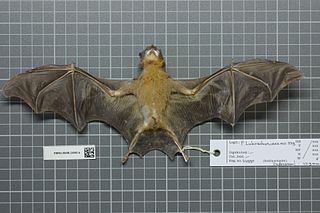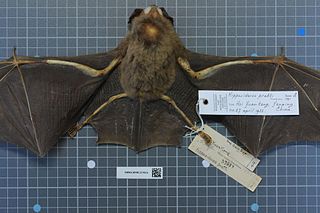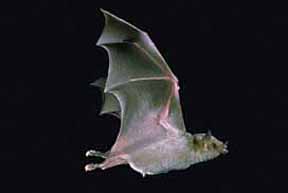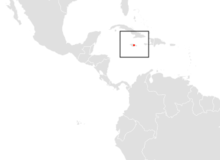
The New World leaf-nosed bats (Phyllostomidae) are found from southern North America to South America, specifically from the Southwest United States to northern Argentina. They are ecologically the most varied and diverse family within the order Chiroptera. Most species are insectivorous, but the phyllostomid bats include within their number true predatory species and frugivores. For example, the spectral bat, the largest bat in the Americas, eats vertebrate prey, including small, dove-sized birds. Members of this family have evolved to use food groups such as fruit, nectar, pollen, insects, frogs, other bats, and small vertebrates, and in the case of the vampire bats, even blood.

The white-winged vampire bat, a species of vampire bat, is the only member of the genus Diaemus. They are found from Mexico to northern Argentina and are present on the islands of Trinidad and Margarita.

The Jamaican, common or Mexican fruit bat is a fruit-eating bat native to Mexico, through Central America to northwestern South America, as well as the Greater and many of the Lesser Antilles. It is also an uncommon resident of the Southern Bahamas. Populations east of the Andes in South America are now usually regarded a separate species, the flat-faced fruit-eating bat. The distinctive features of the Jamaican fruit bat include the absence of an external tail and a minimal, U-shaped interfemoral membrane.

Parnell's mustached bat is an insectivorous bat native to the Americas. It ranges from southern Sonora, Mexico, south to Brazil. It has a wider historical range; fossil specimens have been collected on the island of New Providence in the Bahamas.

The long-tongued fruit bat is a species of megabat. It is nectarivorous, feeding on nectar from primarily banana flowers. It is found in several countries in South and Southeast Asia.

The yellow-throated big-eared bat or orange-throated bat(Lampronycteris brachyotis) is a species of bat that ranges from southern Mexico to Brazil. It is the only species within the genus Lampronycteris. A frugivore and insectivore, it is found in lowland forest up to an elevation of 700 m. Its activity is greatest in the first two hours after sunset, and peaks again after midnight.

The dark long-tongued bat is a species of bat from South and Central America. It was formerly considered the only species within the genus Lichonycteris, but is now recognized as one of two species in that genus, along with the pale brown long-nosed bat. It is small species of bat, with adults weighing 6–11 g (0.21–0.39 oz) and having a total length of 46–63 mm (1.8–2.5 in).

The Antillean fruit-eating bat is one of two leaf-nosed bat species belonging to the genus Brachyphylla. The species occurs in the Caribbean from Puerto Rico to St. Vincent and Barbados. Fossil specimens have also been recorded from New Providence, Bahamas.
The African long-fingered bat is a species of vesper bat in the family Miniopteridae. It is found only in Kenya. It is found in subtropical or tropical moist montane forests. This species is often considered a synonym of Miniopterus inflatus. The holotype was collected in October 1926 by A. M. Bailey. It was described as a new species in 1936 by Colin Campbell Sanborn.

The Jamaican fig-eating bat is a species of bat in the family Phyllostomidae. It is the only living species in the genus Ariteus. The scientific name translates as "yellowish and warlike". There are no recognised subspecies.

The gray short-tailed bat, or Hahn's short-tailed bat, is a species of bat in the family Phyllostomidae native to Mexico and Central America.

The Mexican long-tongued bat is a species of bat in the family Phyllostomidae. It is the only species within the genus Choeronycteris. The species is found in El Salvador, Guatemala, Honduras, Mexico, and the United States.

Pratt's roundleaf bat is a species of bat in the family Hipposideridae. It is found in China, Malaysia, Myanmar, Thailand, and Vietnam.

The greater long-nosed bat or Mexican long-nosed bat is a species of bat in the family Phyllostomidae. It is found in Mexico and the United States. It chiefly consumes pollen and nectar, particularly from agave plants and cacti. Its habitat includes desert scrub and open woodlands. It is threatened by habitat loss.

Leach's single leaf bat, also known as Greater Antillean long-tongued bat, is a species of bat in the family Phyllostomidae. It is found in the southern Bahamas and in all the Greater Antilles. It forms large colonies, with up to a few hundred thousand individuals, and feeds on a relatively wide variety of food items including pollen, nectar, fruit and insects.

The Cuban flower bat, also called Poey's flower bat, is a species of bat in the family Phyllostomidae. It is found on the Caribbean islands of Cuba and Hispaniola.
The Jamaican greater funnel-eared bat is a species of funnel-eared bat found in Jamaica. It was first described as the subspecies Natalus major jamaicensis, later as a subspecies of Natalus stramineus, and more recently as its own species. It is of a similar appearance to many species of the genus Natalus. It lives solely in St. Clair Cave in Jamaica and feeds on insects.

The brown flower bat is a species of bat from the family Phyllostomidae. It is native to the island of Hispaniola, present in both Haiti and the Dominican Republic, and Puerto Rico. In most cases, the brown flower bat is recognized as part of the buffy flower bat, and there are two recognized subspecies: Erophylla bombifrons bombifrons and Erophylla bombifrons santacristobalensis.
Rhinolophus xinanzhongguoensis, the wedge-sellaed horseshoe bat or southwestern China horseshoe bat, is a species of horseshoe bat from China.

Eumops ferox, the fierce bonneted bat or the chestnut mastiff bat, is a species of free-tailed bat found in the Caribbean and Mexico. Until recently, it was synonymous with Wagner's bonneted bat.



















